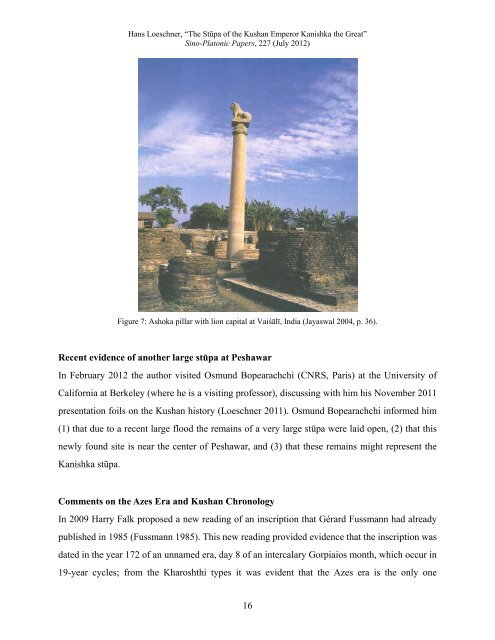The Stūpa of the Kushan Emperor Kanishka the - Sino-Platonic Papers
The Stūpa of the Kushan Emperor Kanishka the - Sino-Platonic Papers
The Stūpa of the Kushan Emperor Kanishka the - Sino-Platonic Papers
Create successful ePaper yourself
Turn your PDF publications into a flip-book with our unique Google optimized e-Paper software.
Hans Loeschner, “<strong>The</strong> <strong>Stūpa</strong> <strong>of</strong> <strong>the</strong> <strong>Kushan</strong> <strong>Emperor</strong> <strong>Kanishka</strong> <strong>the</strong> Great”<br />
<strong>Sino</strong>-<strong>Platonic</strong> <strong>Papers</strong>, 227 (July 2012)<br />
Figure 7: Ashoka pillar with lion capital at Vaiśālī, India (Jayaswal 2004, p. 36).<br />
Recent evidence <strong>of</strong> ano<strong>the</strong>r large stūpa at Peshawar<br />
In February 2012 <strong>the</strong> author visited Osmund Bopearachchi (CNRS, Paris) at <strong>the</strong> University <strong>of</strong><br />
California at Berkeley (where he is a visiting pr<strong>of</strong>essor), discussing with him his November 2011<br />
presentation foils on <strong>the</strong> <strong>Kushan</strong> history (Loeschner 2011). Osmund Bopearachchi informed him<br />
(1) that due to a recent large flood <strong>the</strong> remains <strong>of</strong> a very large stūpa were laid open, (2) that this<br />
newly found site is near <strong>the</strong> center <strong>of</strong> Peshawar, and (3) that <strong>the</strong>se remains might represent <strong>the</strong><br />
<strong>Kanishka</strong> stūpa.<br />
Comments on <strong>the</strong> Azes Era and <strong>Kushan</strong> Chronology<br />
In 2009 Harry Falk proposed a new reading <strong>of</strong> an inscription that Gérard Fussmann had already<br />
published in 1985 (Fussmann 1985). This new reading provided evidence that <strong>the</strong> inscription was<br />
dated in <strong>the</strong> year 172 <strong>of</strong> an unnamed era, day 8 <strong>of</strong> an intercalary Gorpiaios month, which occur in<br />
19-year cycles; from <strong>the</strong> Kharoshthi types it was evident that <strong>the</strong> Azes era is <strong>the</strong> only one<br />
16

















